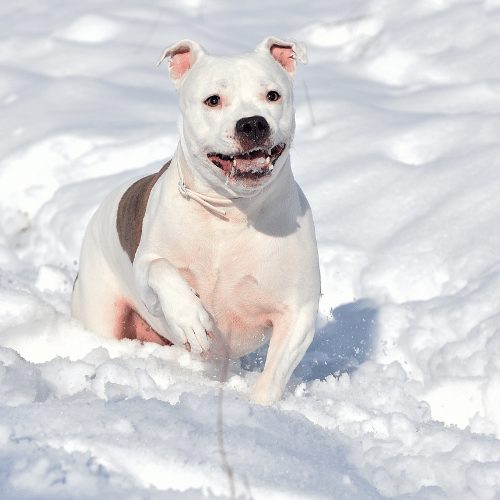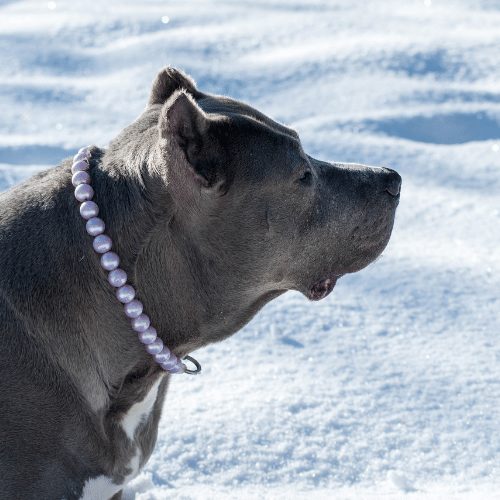With a thick coat and muscular build, pitbulls may seem like they can handle any weather. But did you know that their tolerance to cold temperatures is actually quite limited? While they may appear tough and resilient, pitbulls are not well-equipped to handle extreme cold.
Pitbulls have a short and thin coat, which offers little protection from the cold. This breed is also prone to certain health issues, such as arthritis, which can be exacerbated in cold weather. In fact, pitbulls are more susceptible to hypothermia and frostbite than many other breeds. It is crucial for owners to be mindful of their pitbull’s exposure to cold temperatures and take appropriate measures to keep them warm and safe. This can include providing them with a properly insulated shelter, using protective clothing or dog coats, and limiting their time outside in extreme cold conditions.

How Cold Can a Pitbull Handle?: Understanding Your Dog’s Tolerance to Cold Weather
Pitbulls are known for their strength, loyalty, and resilience. But how well can they handle the cold weather? As responsible pet owners, it’s important to understand the temperature limits that our furry friends can tolerate. In this article, we will explore the factors that influence a pitbull’s ability to handle cold weather and provide tips on keeping them safe and comfortable during chilly seasons.
Understanding the Pitbull’s Coat and Body Composition
Pitbulls have short coats that do not provide as much insulation as longer-haired breeds. While their coats provide some protection against the cold, it’s essential to recognize that they may be more susceptible to adverse effects of low temperatures. Additionally, factors such as age, health, and weight can influence their tolerance to the cold.
The breed’s muscular body composition also plays a role in their ability to handle the cold. Pitbulls have a higher metabolism and body temperature compared to humans, which helps them generate more heat. However, this doesn’t mean they are impervious to freezing temperatures. It’s crucial to consider these factors when determining how long your pitbull can stay outdoors in colder weather.
Factors Affecting a Pitbull’s Cold Tolerance
Several factors impact a pitbull’s ability to handle cold weather. First and foremost, the temperature itself is a significant factor to consider. Pitbulls can generally handle temperatures around 45-50°F (7-10°C) for short periods. However, as the temperature drops, their ability to stay warm diminishes. When the temperature falls below freezing, it is advisable to limit your pitbull’s exposure to the cold.
Another important factor is acclimation. If your pitbull is regularly exposed to colder temperatures, they may develop a tolerance for the cold over time. Conversely, if they are primarily kept indoors in a warm environment, their tolerance to the cold may be lower. Be mindful of their exposure and gradually introduce them to colder temperatures when necessary.
Lastly, consider your pitbull’s individual characteristics. Older dogs, puppies, or those with underlying health conditions may be more susceptible to the cold. Additionally, pitbulls with a lower body fat percentage may lack the insulation needed to stay warm in colder conditions. Understanding your dog’s unique traits will help you assess their cold tolerance effectively.
Tips for Keeping Your Pitbull Safe and Warm in Cold Weather
While pitbulls may be more resilient to colder temperatures than some other breeds, it’s crucial to prioritize their safety and well-being during chilly seasons. Here are some tips to help you keep your pitbull comfortable in the cold:
1. Dress them appropriately: Consider using dog sweaters or jackets to provide added warmth when heading outdoors in colder temperatures. Opt for designs that cover their chest and belly, as these areas are more susceptible to heat loss.
2. Limit outdoor exposure: When the temperature drops below freezing, it’s best to limit your pitbull’s time outside. Short and supervised walks are ideal to prevent them from getting too cold.
3. Create a warm shelter: If your pitbull spends time outdoors, ensure they have access to a warm shelter. Provide insulated bedding and elevate it off the ground to avoid direct contact with cold surfaces.
4. Protect their paws: Cold pavement and ice can be harsh on your dog’s paws. Consider investing in dog booties to protect their paws from freezing temperatures, salt, and chemicals used for de-icing.
5. Maintain hydration and nutrition: Cold weather can be dehydrating for dogs. Ensure your pitbull has access to fresh water and a well-balanced diet to help maintain their overall health and energy levels.
6. Watch for signs of discomfort: Pay attention to any signs of discomfort such as shivering, reluctance to move, or lifting their paws. If you notice these signs, bring your pitbull indoors to warm up.
Remember, every dog is different, and it’s crucial to monitor your pitbull’s behavior and well-being in cold weather. By understanding their cold tolerance, providing appropriate care, and adapting to their individual needs, you can ensure your pitbull stays safe and comfortable during chilly seasons.
Additional Considerations for Cold Weather and Pitbulls
The Importance of Regular Exercise
While it’s necessary to be cautious about exposing your pitbull to low temperatures, it’s equally essential to provide them with regular exercise. Exercise not only helps maintain their physical health but also generates body heat to keep them warm. Engaging in active play indoors or modifying outdoor activities to suit the weather can help meet their exercise requirements during cold spells.
Recognizing Hypothermia in Pitbulls
Hypothermia is a serious condition that occurs when a dog’s body temperature drops below normal. It can be life-threatening if not addressed promptly. Understanding the signs of hypothermia is crucial for every pitbull owner. Symptoms may include shivering, pale gums, weakness, lethargy, and a decreased heart rate. If you suspect your pitbull is experiencing hypothermia, immediately move them to a warm location, cover them with blankets, and seek veterinary care.
Preparing for Extreme Cold Weather
In regions where extreme cold weather is common, it’s important to take extra precautions to protect your pitbull. Consider using heated dog beds or warm pads in their shelter to provide additional warmth. If the temperature drops significantly, it may be safer to keep your pitbull indoors until conditions improve.
Remember, as responsible pet owners, it is our duty to prioritize our pitbull’s safety and well-being in all weather conditions. By understanding their cold tolerance, providing appropriate care and protection, and being vigilant about any signs of discomfort or illness, we can ensure our pitbulls are happy, healthy, and comfortable year-round.
Key Takeaways: How Cold Can a Pitbull Handle?
– A healthy pitbull can handle temperatures around 45-55°F without any issues.
– In colder temperatures, it’s important to provide pitbulls with proper shelter, such as a dog house or insulated crate.
– Pitbulls should wear a sweater or jacket in colder weather to help protect them from the cold.
– Regular monitoring of your pitbull’s behavior and body language is essential to ensure they are not experiencing discomfort or hypothermia.
Frequently Asked Questions
Have questions about how cold a pitbull can handle? We’ve got you covered. Check out these frequently asked questions to learn more.
1. What temperatures can pitbulls withstand?
Pitbulls are generally hardy dogs, but they have their limits when it comes to temperature extremes. While some pitbulls may tolerate colder temperatures, most struggle when the temperature drops below freezing. They are susceptible to hypothermia and frostbite, just like humans.
If you live in a colder climate, it’s crucial to provide your pitbull with adequate shelter and protection. Insulated dog houses and warm bedding can help keep them comfortable, and it’s important to limit their exposure to cold temperatures, especially for extended periods.
2. How can I tell if my pitbull is too cold?
Pitbulls, like other dogs, exhibit certain signs when they’re feeling too cold. Look out for shivering, whining, or excessive reluctance to go outside. If your pitbull starts lifting their paws off the ground or curling into a tight ball, these are also indications that they’re uncomfortable in the cold.
Additionally, you can check their ears, tail, and paws for signs of frostbite. If any of these areas feel unusually cold, hard, or discolored, it’s imperative to warm the dog up slowly and seek veterinary care if necessary.
3. Can pitbulls adapt to cold weather over time?
Pitbulls, like other dog breeds, can adapt to some degree to living in colder weather. They may develop a thicker coat during colder months, providing some insulation against the cold. However, it’s important to note that pitbulls are not naturally equipped to handle extremely cold temperatures.
If you live in a colder region and own a pitbull, it’s best to take necessary precautions to protect them from harsh weather conditions. Proper shelter, winter accessories, and limiting their time outdoors during extreme cold can help ensure their well-being.
4. Are pitbulls more susceptible to cold-related health issues?
Pitbulls are not inherently more susceptible to cold-related health issues than other breeds. However, they may be more prone to certain conditions like hypothyroidism, which can affect their ability to regulate body temperature. It’s crucial to monitor your pitbull’s health and consult with a veterinarian about any concerns or symptoms they may exhibit in cold weather.
Regular check-ups and vaccinations are also essential to keep your pitbull healthy and resilient, regardless of the climate they live in.
5. How can I help keep my pitbull warm in cold weather?
There are several measures you can take to help keep your pitbull warm in cold weather. Investing in a well-insulated dog house can provide them with a cozy shelter, and adding warm bedding like blankets or heated pads can provide extra comfort.
Dressing them in dog sweaters or jackets can help retain body heat, especially during walks or outdoor activities. Limiting their time outside in extreme cold and offering warm water to drink can also assist in keeping them warm and hydrated. Remember, the best approach is to prioritize the well-being of your pitbull and make their comfort and safety top priority.

How to PREPARE your Pit bull for Winter!
Summary
Pitbulls can handle colder temperatures than most dogs due to their muscular build and short hair. However, they still need protection in extreme cold to avoid frostbite or hypothermia. It’s important to provide them with warm shelter, clothing, and limit their exposure to icy conditions.
While pitbulls may be more tolerant of the cold, it’s crucial to pay attention to signs of discomfort or distress. If they start shivering excessively, lifting their paws, or showing signs of lethargy, it’s time to bring them indoors. Remember, even dogs with thick fur can be affected by extreme cold, so always prioritize your pet’s well-being above all else.
